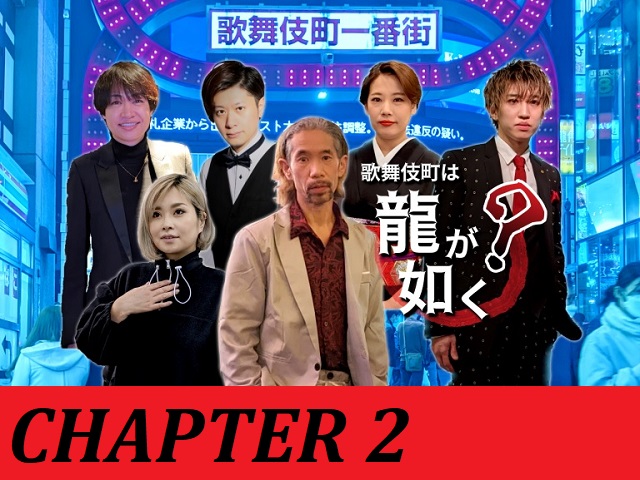
Mr. Sato continues his night out in Kabukicho, the real-world Kamurocho.
Recently our ace reporter, Mr. Sato, hit the streets to see if Kabukicho, the real-world Tokyo neighborhood that serves as the model for Kamurocho in Sega’s Yakuza/Ryu ga Gotoku/Like a Dragon video games series, is as dangerous as its video game counterpart. When we left off, Mr. Sato (dressed in his best Kiryu Kazama cosplay) had just finished Chapter 1: The Fate of Drunkards (as he decided to call the first stage of his investigative quest), and had been told by hostess bar mama Haruka that he should seek out a man named Naruse.
▼ Chapter 2: Towards the Gray Darkness
Following the directions Haruka had given him, Mr. Sato arrived at the Kabukicho Daikan Plaza Seiza Building.
The 10-story structure has some two-dozen drinking establishments inside of it, including a host club called Awake, and that’s where Mr. Sato was headed.
“I’m here to see Naruse,” Mr. Sato told the doorman, followed by “I’ll take a seat here and wait” once he was inside.
Mr. Sato spent a few moments admiring the décor, and then he heard a man’s voice say “I’d be happy to speak with you, Mr. Sato. That is your name, right?”
“I heard about you from Haruka, the mama at Club Haru. She said you wanted to ask me something?” Naruse said, easily flashing a welcoming smile with all the charm of a host club industry veteran.
“Yes. Tell me about Kabukicho,” Mr. Sato replied, adopting the broad yet straightforward conversational technique of a video game protagonist. Unfortunately, that’s not always the best communication style to use in real life, but Naruse handled the awkwardness with aplomb. “What sort of things would you like to know? I’m not sure where to start with just ‘Kabukicho.’”
“Ah, yeah, I guess not. Well, I’d like to know how Kabukicho was back in the old days,” Mr. Sato expanded, since Naruse has worked in the neighborhood for over 20 years. “I’m guessing that Kabukicho used to be a much more dangerous place than it is now.”
“I see,” Naruse said, adopting a pensive expression as he mentally looked back over that time.
Naruse: “If we’re talking about my line of work, back when I first started I’d say the hosts were harder partiers. They’d get really drunk sometimes, and it seemed like there was no end to fights between them.”
Mr. Sato: “Seriously? The hosts would get into fights with each other? Like, over stealing customers away from each other?”
Naruse: “Back in the day, most hosts were rough, thuggish guys. There were a lot of fights that started because of ‘urikake’ [credit sales].”
Mr. Sato: “Urikake?”
Naruse: “In the host industry, urikake is a system where, if the customer doesn’t have enough money to settle her bill at the end of the night, the host that was drinking with her pays off the rest of the balance. Then the customer is supposed to come back on a later date and pay back that amount. Sometimes, though, the customer wouldn’t have paid the amount back yet, but they’d find out she was drinking with a different host at a different bar, so then the hosts would get into it.”
Mr. Sato: “Ah, so the host who used his money to pay the customer’s bill, but hadn’t been paid back, would get upset.”
Naruse: “Right. Sometimes they’d be out on the street and see the customer walking around with a different host, and they’d confront them and say ‘Give me my money.’ Really, though, it’s the customer who’s causing the problem. Recently though there are hardly any hosts who start fights like that.”
Mr. Sato: “It sounds like it was a rougher era.”
Naruse: “Speaking of that, hosts used to go out on the street and tout for their clubs” [This practice is now prohibited in Kabukicho]
Mr. Sato: “Oh, yeah, I remember seeing a lot of hosts gathered in front of the Don Quijote store at the entrance to Kabukicho. People called them ‘the crows.’”
Naruse: “Don Quijote was like a battleground. Hosts would claim territory there, and if a new host showed up and started touting, there’d be fights. You’d also see tough guys purposely walk through the crowd with their date, and if a host talked to her, they’d get up in their face and say, ‘The hell you think you’re doing to my girl, huh?’”
Mr. Sato: “Whoa. Sounds like Kabukicho was a seriously sketchy place. So are things safer now?”
Naruse: “Hmm. Well, the dangerous parts were really noticeable, but that made them easy to spot too. There were strict rules about how people conducted themselves, but as long as you followed them, you usually wouldn’t run into any trouble. When there were fights, there was a certain amount of justification to them, and it was an era of a kind of masculine logic.”
Mr. Sato: “But now?”
Naruse: “It’s harder to spot where the danger comes from. I hear about people getting sucker punched, or getting doxed on social media as part of a beef. It feels like because there aren’t so many physically intimidating guys running around, some people go way overboard.”
Mr. Sato: “Instead of the safe and dangerous parts being easy to differentiate, it’s gotten gray, huh?”
Naruse: “Yeah, that’s my impression…Hey, if you want to hear some wild stories, there’s someone named Saito who’d have some for you.”
And so Mr. Sato saved his progress, and we’ll be back soon with Chapter 3: Crazy Town.
Related: Awake
Address: Tokyo-to, Shinjuku-ku, Kabuki-cho 1-2-7, basement level 1
Open 7 p.m.-midnight
Website
Photos ©SoraNews24
● Want to hear about SoraNews24’s latest articles as soon as they’re published? Follow us on Facebook and Twitter!
[ Read in Japanese ]